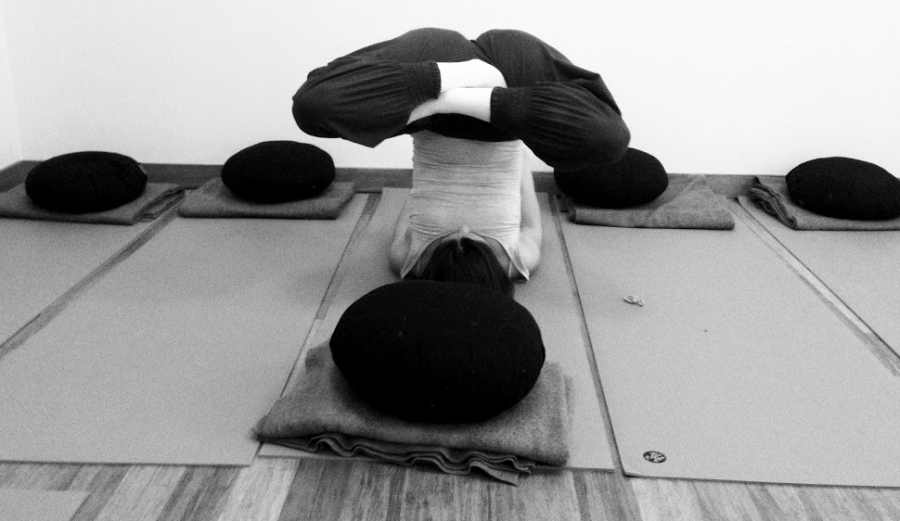Mind the Body: Yoga added to students’ schedules
Senior Jozy Belay poses in a shoulder stand in the new mindfulness studio.
Down in the basement, beyond the cafeteria and the lockers, through the ceramics room, nestled in secluded corner of Lincoln, students move from through downward dog to child’s pose, from cat to cow pose. Later, they sit quietly, focusing on their breath. Neatly lined with blue mats and pillows, illuminated by orb-like lamps, a classroom has been transformed into a haven of relaxation.
It is also the classroom of new teachers Erin Burke and Janice Ownbey, who teach two new classes: mindfulness and yoga. The latter includes both mental work, which Ownbey teaches, and physical, which Burke teaches. Meanwhile the yoga classes stretch the body and let the mind follow.
“We’re super excited to have a mindful studies class at Lincoln,” says Ownbey.
Mindfulness was first offered at Wilson last year, where it was the first of its kind to be offered for credit at a public school in the United States. Now, thanks to the non-profit Peace in Schools, for whom Ownbey works, the program has expanded to Lincoln.
Mindfulness, according to a sheet handed out to students, is “the practice of focusing one’s attention on the present moment, without judgement and with compassion to promote greater awareness of oneself and one’s environment.”
A typical mindfulness class begins with movement, which prepares the body mental exercises, such as journaling, group discussions, guided imagery, and visualizing positive scenarios. Yoga class is almost entirely physical, with about 75 minutes of every period being dedicated to doing poses.
“Everything in the class is designed to support the student and help the students have an experience for themselves,” says Ownbey.
As for the teachers’ experience, Burke worked for five years at another IB school in Colorado where she primarily taught English. She completed her first yoga teacher training in 2002 and most recently completed three levels of training under instructor Sianna Sherman in 2011. At Lincoln, she has three periods of mindful studies, two of yoga and one of creative writing.
“This job came up for yoga teacher [and] it was my dream job,” she says. “It changed my life when I started doing yoga so I wanted to share that with kids.”
Ownbey, too, came from outside Oregon — New York — for the opportunity to teach.
“When the opportunity came up for me to teach mindful studies, I jumped on it because I’m just so excited to be sharing this practice.”
Both have long histories with their disciplines. Burke recalls going over to a friend’s house as a child and watching a yoga TV program to practice. Ownbey was drawn to her mindfulness after encountering difficulties abroad during college.
“I was looking for a new way to approach life because I was realizing that my coping mechanisms weren’t working,” she says. “This practice has been that for me, and more, and I feel so glad to share it because it’s an amazing tool.”
Sophomore Job Nollette agrees.
“Mindfulness and being mindful allows me to see stress in my life and and reflect on it,” he says.
Stress melts away in the studio, where all of Burke and Ownbey’s classes meet. Burke designed the studio herself. Using donations from the booster club, a rebuilding center and a discount from a yoga supply brand, she crafted the perfect space, from the wall color to the lighting. Parent volunteers pitched in to make it a reality by leading construction and building plywood cabinets for supplies.
Both Burke and Ownbey highlighted the importance of classes like Mindfulness and Yoga in a high school. “Our world is so fast-paced with the cell phones and the technology and also the intense academics,” says Burke. “[These classes] give the students the space to give themselves the gift of their own attention.”
Burke pointed to studies that show that practicing yoga and mindfulness rewires the human brain. “The part of the brain that is for memory or learning grows and the part of the brain that is for stress reduces,” she says.
“The goal,” Ownbey adds, “is for students to walk away with a practice that they can use in their daily lives.” The techniques they learn, the teachers say, can be a new approach for coping with crisis – both the large and small issues of high school, and the stresses of life in years to come. The intention, Ownbey adds is for “students to walk away with a practice that they can use in their daily lives to ease stress.”

